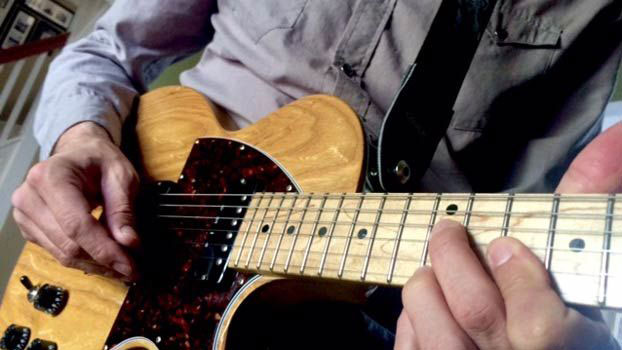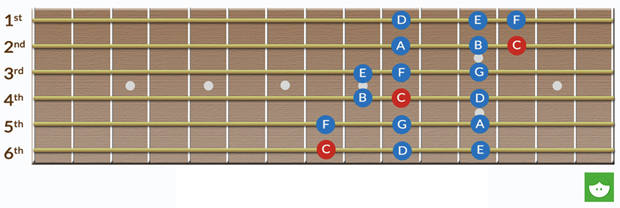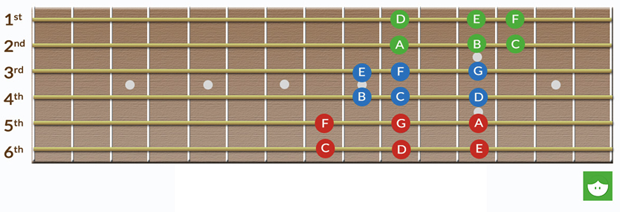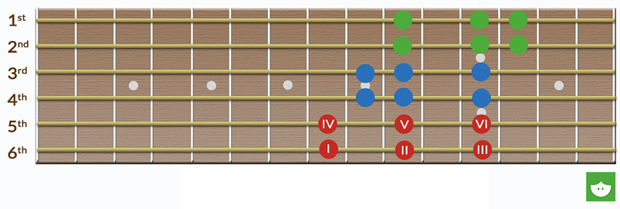Achieving Absolute Fretboard Mastery, Part 7
Learn how to visualize the notes across your entire fretboard more easily and clearly with this lesson.

Steve Stine, highly sought-after guitar educator, teaches live online group and private classes at Lessonface.com.
Hey, guys! Welcome back to my ongoing "Absolute Fretboard Mastery" series.
In this month’s edition, we’re going to be drawing on the knowledge of chord progressions we touched on last month and the pentatonic expansion theories we covered in the months before to finally get into a fully fledged major scale.
By the way, be sure to check out all the previous parts of "Absolute Fretboard Mastery."
So, to start things off this month, let’s take a look at a C major scale in the following shape:

This is what is called a "spread fingering shape." When I was first learning my scales, I didn’t learn them in this spread-fingering shape. I learned them in what’s commonly referred to as the "box positions." The same C major scale played using a box position would look like this:

While these box positions are great for navigating the fretboard, something I've learned with them is that they can feel pretty awkward to play and to speed up — which is why the spread-fingering position made a lot more sense to me when I started learning it.
For one thing, the symmetry of the spread fingering position is far easier to process on a visual level. If we were to break up the note groupings on each two strings, they would look like this:

As you can see, the patterns of notes is the same on the sixth and fifth, fourth and third and second and first strings. This visual symmetry of the spread-fingering shape make it far easier to memorize and also far easier to navigate while playing. Something you also will notice with this spread-fingering shape is that, because you are playing three notes on each string, instead of switching between two and three notes like in the box positions, it is far easier to maintain a consistent picking pattern throughout the scale. This, in turn, makes this shape far smoother to play and far easier to speed up.
Another great thing about this spread-fingering shape is that, from a theoretical perspective, it makes it much easier to visualize your scale intervals and to navigate across them. Say, for instance, you want to figure out how your I, III and V intervals sound when played together. You can do so easily by using this spread fingering position.

When it comes to your soloing, this familiarity with your scale intervals is important because it can help you get a feel of what notes to play and when to play them. Say, for instance, you’re soloing over a C chord.
By now you’ll know that the I, III and V intervals of the scale are going to sound comfortable. But ideally at this point you should start experimenting with adding the II, IV and VI notes to add more color to your solos. The visual ease of recognizing these scale intervals with the spread fingering position will make it much easier for you to expand your playing into what we call "intervallic playing" instead of simply playing up and down the scale.
You see, memorizing these scale positions and notes is the easy part about playing guitar. The real challenge is in using this knowledge and theory to create actual music. So the first thing I want you to do this month is to learn and memorize this shape, not just in C but across the entire fretboard.
The second thing I want you to do is to start experimenting with it over a C major jam track. And while you’re doing that, what I really want you to focus on is going beyond the I, III and V notes and really exploring the sound of the II, IV and VI notes over the jam track.
Another small thing I want you to work on this month is learning and memorizing the notes on your G string. If you’ve followed my Absolute Fretboard Mastery series from the beginning, you will remember we’ve already learned and memorized the notes on the sixth, fifth and fourth strings. And like with those strings, remember to cross reference the notes you learn on the G string with the notes on the three strings above it.

The reason I want you to cross reference these notes you learn is because it will help you ultimately visualize the notes across your entire fretboard easily and clearly. And this, along with the scale knowledge that we’ve been working on the past few months, all contribute towards your absolute mastery of the fretboard. So as always, practice hard and have fun with your playing, and I’ll see you next month.
Steve Stine is a longtime and sought-after guitar teacher who is professor of Modern Guitar Studies at North Dakota State University. Over the last 27 years, he has taught thousands of students, including established touring musicians, and released numerous video guitar lesson courses via established publishers. A resident of Fargo, North Dakota, today he is more accessible than ever before through the convenience of live online guitar lessons at Lessonface.com.
Get The Pick Newsletter
All the latest guitar news, interviews, lessons, reviews, deals and more, direct to your inbox!
“There are so many sounds to be discovered when you get away from using a pick”: Jared James Nichols shows you how to add “snap, crackle and pop” to your playing with banjo rolls and string snaps
Don't let chord inversions bamboozle you. It's simply the case of shuffling the notes around







![Joe Bonamassa [left] wears a deep blue suit and polka-dotted shirt and plays his green refin Strat; the late Irish blues legend Rory Gallagher [right] screams and inflicts some punishment on his heavily worn number one Stratocaster.](https://cdn.mos.cms.futurecdn.net/cw28h7UBcTVfTLs7p7eiLe.jpg)


